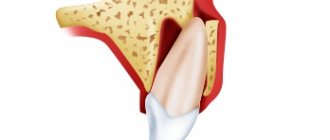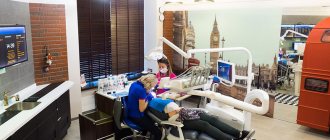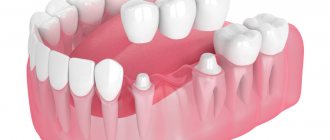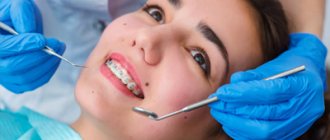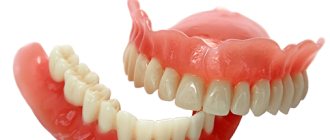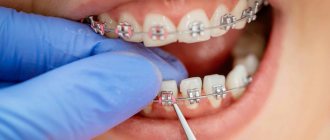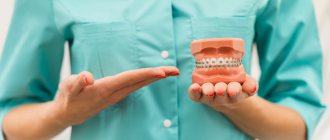Immediately after installation, braces can rub the oral mucosa and cause irritation. In most cases this is normal, you just need to be patient. If the discomfort does not go away and the symptoms intensify, you should see a doctor. In this article we will tell you what to do if your braces rub your cheeks, lips or tongue.
In this article
- When rubbing the mucous membrane with braces is the norm
- Braces rub cheeks: reasons
- What to do if braces rub your cheeks
- Wax for braces to prevent chafing
- Hygiene after installing braces
Braces are complex orthodontic structures consisting of many small parts. They are made from different materials - ceramics, plastic, sapphire or metal. Regardless of the type of system, the arc in it is always metal. It has memory and after installing braces it begins to return to the shape that was given to it during system modeling. She puts pressure on the teeth, gradually moving them in the desired direction. Due to this, the bite is slowly corrected and irregularities in the dentition are eliminated.
Braces place quite a lot of stress on the jaws. Immediately after their installation, a person feels discomfort in the oral cavity and even pain. Usually, unpleasant symptoms disappear within a few days or weeks.
People often complain that braces rub or scratch their lips and cheeks, causing small sores that bleed and hurt, especially when eating. In some cases, irritation of the tongue mucosa is observed, which can occur after the installation of lingual braces fixed on the inside of the dentition. Let's find out when such symptoms are normal and when they are not.
When rubbing the mucous membrane with braces is the norm
The oral mucosa is covered with a thin epithelial layer, penetrated by many blood vessels. Minor injuries, some products and orthodontic structures can disrupt its integrity and cause irritation. Braces are a foreign object for the body, which, when in contact with the mucous membrane, can cause a certain reaction. This happens especially often when teeth protrude strongly towards the cheeks or lips. In addition, the design itself is quite voluminous, so in some sense it increases the size of the jaw. Because of this, the contact of braces with the tissues of the oral cavity becomes more dense.
The mucous membrane recovers very quickly, without any treatment. Within a few days after installing the braces, a person ceases to feel any discomfort. If the problem does not go away, and the symptoms of damage to the mucous membrane intensify, you need to consult a doctor.
The following signs may be a reason for a visit:
- bleeding of the mucous membrane;
- pain while eating;
- the formation of ulcers and wounds covered with a white film.
If an infection gets into the wound, an inflammatory process will begin. Therefore, if you are concerned about several of the listed signs, do not try to eliminate them yourself. Most likely, the cause of these symptoms is not related to adaptation.
Useful tips
The occurrence of unpleasant sensations during treatment with braces is inevitable, but their severity can be minimized if you follow a number of medical recommendations:
- Forget about chewing gum during treatment . This product has a viscous substance that can easily damage the system. Moreover, it is very difficult to clean it from the surface of the bracket. And the sticky structure of the substance becomes a favorable environment for the colonization of bacteria.
- Use a brush with gentle bristles to hygienically clean your mouth and teeth . Such a device will not injure soft tissues. It is advisable to purchase a special brush for braces at the pharmacy.
- Limit your intake of acidic foods . They can cause irritation of the mucous membrane.
- Try to eat mostly soft foods . Avoid croutons, crackers, bagels, nuts, pears, apples, and other solid foods. Before eating raw fruits and vegetables, try to chop them into small pieces, otherwise there is a risk of breakage or displacement of the device and subsequent chafing.
- During the adjustment period, rinse your mouth regularly with saline solution. This simple remedy reduces pain and perfectly disinfects wound areas.
- Try to talk less and move your lips for the first 3 days after installing braces , so as not to rub the inner lining of your mouth out of habit.
- Sleeping on your stomach during treatment is prohibited , as this can damage the structure, which will result in injuries to living tissues.
- If, for various reasons, the lock is damaged or comes off the surface of the tooth, do not try to solve the problem on your own . Urgently make an appointment with your treating orthodontist, who will expertly eliminate the problem.
- Buy toothpaste containing potassium nitrate at the pharmacy . With this product, the sensitivity of soft tissues to rubbing effects will be significantly reduced.
- For severe pain, use local “freezes”. Anestezin ointment is considered one of the most effective remedies in this group. It promotes rapid healing of wounds and effectively eliminates pain.
It is advisable to change the hygiene product periodically. For example. Use the anti-inflammatory paste for 1 month, and then replace it with a calcium-containing product for the same period.
The video provides additional information on the topic of the article.
Braces rub cheeks: reasons
There are four possible reasons why braces chafe your cheeks, lips, and tongue. Among them:
- Error when installing the arch of the orthodontic structure. The orthodontist may incorrectly trim or bend the archwire, making it too long. As a result, it begins to scratch the tissues of the oral cavity. The problem is eliminated by partially dismantling the system and reinstalling the arc.
- The lock has come unglued from the enamel. One of the main parts of the structure is the locks, which are fixed to the tooth surface using dental cement. If one of the locks has lost contact with the enamel and become detached, it will most likely rub against your cheek or lip. This rarely happens, since the fixation of the braces should be as tight as possible so that they do not move even as a result of pressure. This may lead to incorrect correction. However, the likelihood of such a complication still exists, albeit low.
- The arch of the braces jumped out of the slots of the locks. This problem also occurs rarely. The reason for its appearance is an error when installing braces or non-compliance with the rules for wearing them. Thus, a person may press too hard on the system with a toothbrush or damage it when consuming hard foods, such as carrots. If the arch from the braces jumps out of the grooves, it begins to come into contact with the mucous membrane and rub it.
- Allergy to construction material. Sores, wounds, bleeding and other symptoms may be the result of an allergic reaction. Often it occurs on some metal. In this case, it is necessary to reinstall the system, and you will have to replace it with plastic, sapphire or ceramic. You may need to give up braces in favor of aligners.
In some cases, the adaptation period is delayed, which is associated with the individual characteristics of the body, for example, increased sensitivity of the mucous membrane. To reduce the risk of developing inflammatory diseases, it is recommended to carefully observe the rules of hygiene and eat right.
Alarming symptoms
If the irritation does not go away after a few days, and the resulting abrasions cause physical discomfort, it is recommended not to delay visiting your doctor for a re-examination. Prolonged exposure to mucous tissue leads to the formation of foci of erosion, the formation of ulcers and constant bleeding, and also causes pain, which increases in proportion to the load on the jaw region.
Modern models of braces differ markedly from the correctors used in orthodontics in the last century. Modeling and processing technologies guarantee anatomical conformity to the configuration, and ensure the smoothness of the surface of the bases and fastenings. Uncomfortable sensations caused by constant rubbing indicate the presence of deviations from the norm, which can be caused by the following factors:
- An increase in the length of the power arc due to changes in the shape of the dentition;
- Failure to comply with medical recommendations during hygiene procedures;
- Departure of ligatures or braces from the enamel coating;
- Displacement of crowns located near the edentulous area.
It is strongly not recommended to ignore negative symptoms - pain, bleeding, swelling of tissues, since the development of an abnormal condition leads to complications. The presence of an affected area in the oral cavity increases the likelihood of infection, which results in a weakening of the periodontal structure, as well as the risk of the formation of complex pathologies.
What to do if braces rub your cheeks
If discomfort in the oral cavity does not go away after installing orthodontic braces, you will need the help of a specialist. Depending on the cause of the problem, he will select a method to eliminate it:
- glue the detached lock to the tooth surface, having previously removed the old glue with a solvent;
- will cut off both edges, bend and reinstall an arch that is too long;
- will put the arch in place if it has jumped out of the grooves due to the patient violating the rules of wearing braces;
- will replace the arc with a product made of a different material if the discomfort is caused by an allergy.
It is also necessary to help the patient quickly adapt to the design. To do this, he is prescribed special gels and ointments that can be used at home. If ulcers form, the doctor will select a healing or anti-inflammatory ointment to prevent the spread of infection.
Provocateurs of the problem
Modern braces systems are designed for maximum patient comfort. Their design features and parameters differ in a number of advantageous criteria:
- miniature size;
- material with zero allergenicity;
- rounded edge lines with smooth transitions.
Such products should not cause unnecessary inconvenience during operation. But even with perfect designs, a period of adaptation is inevitable.
Injuries to the mucous membrane and inflammation occur more often due to a number of reasons, namely:
- the fixation of the bracket is broken, and having peeled off from the surface of the tooth, its edges rub the mucous membrane;
- part of the arch without silicone protection, in the place of the missing tooth unit, digs into the tissue of the cheek;
- arc displacement. During the process of eating or hygienically cleaning teeth, the arch jumped out of several grooves of the brackets;
- parts of metal ligatures, which look like the thinnest wire, do not fit tightly to the surface of the tooth, and as a result of cleaning with a hard brush, they scratch the mucous membrane;
- individual intolerance to the metal from which the braces are made, which is reflected by inflammatory processes in the soft tissues of an allergic nature;
- inappropriate length of the arc, which has taken an irregular shape and scratches the inside of the cheeks with the end sections of the wounds.
The listed troubles are eliminated in a clinical setting. It is important that a qualified doctor deal with the problem.
Experts take actions based on the definition of the provocateur of the problem:
- The unfixed bracket is glued to the tooth surface again, having previously cleaned the working area from the remnants of the previous glue.
- An arc that is too long is cut off at the edges and bent optimally.
- The doctor carefully bends the bent ligature into place using special tools.
- The arc that has jumped out of the grooves is carefully inserted into place, trying not to disturb the optimal position of the system as a whole.
- In case of severe allergic reactions to metal, the doctor recommends replacing the plate material. Materials such as ceramics and plastic have proven themselves to be excellent.
Important! Because During treatment, the mucous membrane has to constantly come into contact with foreign elements (arc, ligatures, fastenings), rubbing of soft tissues in areas of deployed, curved and protruding elements is inevitable.
However, due to the excellent regenerative ability of the mucous membrane and the bactericidal properties of saliva, adaptation to the corrective system occurs quickly.
Wax for braces to prevent chafing
If braces rub the cheek, the dentist may prescribe orthodontic wax - a special composition that is applied to the structure to protect the mucous membrane from rubbing. The composition of such products is hypoallergenic, so they are suitable for all patients. Wax is recommended to be used not only during the adaptation period, but also after tightening the braces. It should be used according to the instructions:
- Dry the part of the structure that will be waxed using cotton swabs.
- Tear off a small piece of the mixture, warm it with your fingers and roll it into a small ball.
- Attach it to the protruding part of the staples using light pressure (the wax should not be under the metal elements of the structure).
Before eating, you need to remove the wax from the braces with a brush, cotton swab or brush. But nothing bad will happen even if you swallow a little of this product. It is absolutely safe for health, including for children.
If your braces continue to scratch your cheek or lips even with wax, the system may need to be removed. The need for this will be determined by an examination.
Hygiene after installing braces
After installing braces, the requirements for oral hygiene increase, especially during the period of adaptation to the system. If you don't brush your teeth or do it poorly, germs can get into the wounds caused by rubbing. Due to the infection, treatment will be delayed. It is possible that you will have to remove the staples, treat the pathology and put them back on.
To prevent this, use special hygiene products to care for braces: brushes, dental floss, mouthwash with antibacterial properties and a special brush with V-shaped bristles.
Orthodontists also recommend cleaning your mouth 2-3 times a week with an irrigator. It is necessary to select devices with attachments designed for the care of orthodontic systems, for example, Little Doctor International Ltd Aquajet LD-A7 and Donfeel Donfeel OR-820D Compact. Before purchasing brushes and other hygiene products, consult your doctor.
Remedies
Unfortunately, the patient does not always have the opportunity to quickly seek medical help if the orthodontic system has rubbed the cheek. You can get rid of discomfort or reduce its severity at home with the help of medications .
Doctors recommend:
- Take a medicine with anti-inflammatory and analgesic effects. Local anesthetics are available in pharmacies without a doctor's prescription. Instructions for use are included.
- Rinse your mouth with a disinfectant solution. This procedure will eliminate signs of inflammation, disinfect the wound, and reduce swelling and pain.
If a person is away from the pharmacy, and the problem requires an emergency solution, you can close the problematic brace that is rubbing with candle wax.
Doctors prohibit the use of tree resin, tar, and chewing gum. Removing one of the listed substances can easily damage the system.
In addition, their surface and structure are an ideal environment for bacterial production, which inevitably leads to the development of infectious processes.
Also, orthodontists advise taking the following measures:
- promptly eliminate the cause of chafing;
- help soft tissues get used to the device;
- treat emerging inflammatory processes and ulcers.
To facilitate the adaptation period, immediately after installing braces, the specialist gives the patient orthodontic wax. This remedy quickly relieves inflammation and prevents further injury to soft tissues.
If the product was not dispensed at the clinic, it can be purchased at a specialized pharmacy.
About the use of orthodontic wax
Dental wax in orthodontics is considered an indispensable means of caring for the braces system and all tissues of the oral cavity.
To go through the therapeutic corrective period with benefit and maximum comfort, it is important to stock up on effective wax for braces.
Pieces of this product can quickly and easily seal problem areas of the system, thereby avoiding their traumatic contact with the mucous membrane. Wax also allows you to disguise unpresentable plates.
In appearance, the material is a mass of dense consistency. The product is made from natural raw materials and medical polymer. The natural component of the product allows you to completely hide the system or its individual sections. And silicone provides the substance with optimal elasticity.
Today, waxes with anti-inflammatory and antiseptic effects are very popular, which perform not only protective, but also therapeutic functions - after use, wounds and scratches heal faster.
Any means used in orthodontics and in medicine in general must be used correctly. Orthodontic wax is no exception. Instructions:
- Thoroughly clean the oral tissues and teeth using a soft-bristled brush;
- dry the surface of the tooth and the problematic plate using a thick cotton swab;
- cut a small piece of wax, strictly controlling the size of the fragment (it should completely cover the bracket that needs to be closed);
- soften the material in your palms and use your fingers to form a small ball out of it;
- attach the resulting ball to the surface of the plate;
- wait a few minutes until the material spreads over the desired area;
- remove excess mass.
Despite the fact that orthodontic wax is considered a hypoallergenic product, doctors insist on removing it before each meal. After eating, the mixture can be applied to the surface of the bracket again.
Remember! Dental wax does not belong to the group of drugs, therefore there are no quantitative or time restrictions in the process of its use.
Using overlays
Small shifts and changes in the corrective structure have an impact on the health of oral tissues and their integrity.
In addition to correcting the bite, orthodontic onlays on the teeth prevent the jaws from completely closing during eating, thereby reducing the risk of injury to the cheeks and lips from the elements of the apparatus.
The work of such overlays is aimed at the following protective functions:
- holding the entire structure in a given position;
- reducing the load on the dental system, apparatus and chewing units;
- protection of oral tissues from inflammatory processes that develop from traumatic contact with parts of the structure.
In orthodontics, onlays are palatal devices with specialized design features. The product includes the following elements:
- metal clasps for fixing the plate;
- an arched element for the lip area (it is a connecting link for clasps);
- bite platform , made in accordance with the jaw structure.
Installation steps:
- installation of bite fillings on the surface of the lateral teeth of the upper and lower jaws;
- corrective actions on onlays using various dental techniques;
- correction of the material as it is erased.
As soon as the adaptation period is completed and the braces stop rubbing the inner surface of the cheeks and lips, the orthodontist painlessly grinds off the braces for the patient.
While wearing such assistive devices, the patient must monitor their condition. If the onlay has crumbled and the braces system has changed its position due to this, it is important to immediately notify the doctor.
Application of silicone
Protective silicone is intended for temporary closure of problematic elements of the corrective apparatus. The product effectively protects tissues from irritation and provides a person with maximum comfort during the treatment process.
Silicone has a long service life and, according to patients, is fixed more reliably than wax.
To use this type of protection, you will need to perform a few simple steps:
- tear off a small piece of material from the entire plate;
- soften it with your fingertips;
- place on the surface of the bracket.
Silicone is able to close all protruding parts of the system, ensuring safe contact of living tissues with foreign parts.
Advantages of the material:
- absolute harmlessness;
- absence of additional impurities;
- increased hypoallergenic properties.
The work of silicone is aimed at the following actions:
- acceleration of adaptation of the mucous membrane to the installed structure;
- protection of living tissues from damage by braces;
- reducing the friction force of the system on the inside of the lips and cheeks;
- preventing friction of the arcuate element with the lock;
- relief of the condition before visiting the doctor after the arch falls out of the grooves.
To make the process of correcting malocclusion easier, experts recommend using other special designs and anti-chafing products.
Here you can highlight special hygiene products, various buttons, as well as elastic cords that increase pressure on the elements of the dental cord in a certain area. The main thing is that the structure has the correct position in the oral cavity and that there are no protrusions.
Is whitening always required after removing braces and what is the best method to use?
In this publication, you can determine the aesthetics of titanium braces from patient photos.
Here https://zubovv.ru/ortodontiya/breketyi/vestibulyarnyie/osobennosti-modeley-sia.html we will look at the design of Sia braces.
